PVP-Engineered WO3/TiO2 Heterostructures for High-Performance Electrochromic Applications with Enhanced Optical Modulation and Stability
Abstract
1. Introduction
2. Experimental Section
2.1. Reagents and Materials
2.2. Electrodeposition of WO3 on FTO Substrates
2.3. Hydrothermal Growth of TiO2 on WO3 Films
2.4. Electrochromic Device Fabrication
3. Sample Characterization and Electrochemical Measurements
4. Results and Discussion
4.1. X-Ray Diffraction (XRD)
4.2. X-Ray Photoelectron Spectroscopy (XPS) Analysis
4.3. Morphological and Elemental Compositional Characteristics
4.4. Transmission Electron Microscopy (TEM) Analysis
5. Electrochromic Analysis
6. Electrochromic Device Performance
7. Conclusions
Author Contributions
Funding
Institutional Review Board Statement
Data Availability Statement
Conflicts of Interest
References
- Li, B.; Dang, J.; Zhuang, Q.; Lv, Z. Recent Advances in Inorganic Electrochromic Materials from Synthesis to Applications: Critical Review on Functional Chemistry and Structure Engineering. Chem.-Asian J. 2022, 17, e202200022. [Google Scholar] [CrossRef] [PubMed]
- Reyes-Gil, K.R.; Stephens, Z.D.; Stavila, V.; Robinson, D.B. Composite WO3/TiO2 Nanostructures for High Electrochromic Activity. ACS Appl. Mater. Interfaces 2015, 7, 2202–2213. [Google Scholar] [CrossRef] [PubMed]
- Afik, N.; Murugesan, S.; Shreteh, K.; Fridman, H.; Hijaze, Y.; Volokh, M.; Mokari, T. Synthesis of Ultrathin Alloy (Mo, V)-Tungsten-Oxide Nanowires: Implications for Electrochromic and Supercapacitor Applications. ACS Appl. Nano Mater. 2024, 7, 5878–5888. [Google Scholar] [CrossRef]
- Amate, R.U.; Morankar, P.J.; Teli, A.M.; Bhosale, M.K.; Ahir, N.A.; Jeon, C.W. Interface-Centric Strategies in Nb2O5/MoS2 Heterostructure: Leveraging Synergistic Potential for Dual-Function Electrochromic Energy Storage. Chem. Eng. J. 2025, 511, 161962. [Google Scholar] [CrossRef]
- Gu, C.; Jia, A.B.; Zhang, Y.M.; Zhang, S.X.A. Emerging Electrochromic Materials and Devices for Future Displays. Chem. Rev. 2022, 122, 14679–14721. [Google Scholar] [CrossRef]
- Lee, J.H.; Kim, H.; Hwang, J.Y.; Chung, J.; Jang, T.M.; Seo, D.G.; Gao, Y.; Lee, J.; Park, H.; Lee, S.; et al. 3D Printed, Customizable, and Multifunctional Smart Electronic Eyeglasses for Wearable Healthcare Systems and Human-Machine Interfaces. ACS Appl. Mater. Interfaces 2020, 12, 21424–21432. [Google Scholar] [CrossRef]
- Zhang, W.; Li, H.; Hopmann, E.; Elezzabi, A.Y. Nanostructured Inorganic Electrochromic Materials for Light Applications. Nanophotonics 2020, 10, 825–850. [Google Scholar] [CrossRef]
- Gao, M.; Bao, Y.; Qian, Y.; Deng, Y.; Li, Y.; Chen, G. Porous Anatase-TiO2(B) Dual-Phase Nanorods Prepared from in Situ Pyrolysis of a Single Molecule Precursor Offer High Performance Lithium-Ion Storage. Inorg. Chem. 2018, 57, 12245–12254. [Google Scholar] [CrossRef]
- Fan, X.; Pan, M.; Li, X.; Kong, L.; Kuchmizha, A.; Xu, H. Research Progress of MOF Electrochromic Materials. Resour. Chem. Mater. 2024, 3, 230–245. [Google Scholar] [CrossRef]
- Wen, R.T.; Granqvist, C.G.; Niklasson, G.A. Eliminating Degradation and Uncovering Ion-Trapping Dynamics in Electrochromic WO3 Thin Films. Nat. Mater. 2015, 14, 996–1001. [Google Scholar] [CrossRef]
- Morankar, P.J.; Amate, R.U.; Teli, A.M.; Beknalkar, S.A.; Jeon, C.W. Exploring Electrochromic Performance via Layered Deposition of Tungsten Oxide on Niobium Oxide Composite Electrode. J. Power Sources 2024, 613, 234930. [Google Scholar] [CrossRef]
- Cai, G.F.; Zhou, D.; Xiong, Q.Q.; Zhang, J.H.; Wang, X.L.; Gu, C.D.; Tu, J.P. Efficient Electrochromic Materials Based on TiO2@WO3 Core/Shell Nanorod Arrays. Sol. Energy Mater. Sol. Cells 2013, 117, 231–238. [Google Scholar] [CrossRef]
- Lv, Z.; Yang, D.; Mo, J.; Jin, Z.; Chang, S. Construction of TiO2/WO3/TiO2 Double Heterojunction Films for Excellent Electrochromic Performance. Sci. Rep. 2024, 14, 11443. [Google Scholar] [CrossRef]
- Nah, Y.C.; Ghicov, A.; Kim, D.; Berger, S.; Schmuki, P. TiO2-WO3 Composite Nanotubes by Alloy Anodization: Growth and Enhanced Electrochromic Properties. J. Am. Chem. Soc. 2008, 130, 16154–16155. [Google Scholar] [CrossRef]
- Ninh, D.H.; Thao, T.T.; Dinh, N.N.; Long, P.D. Characterization of Structural and Electrochromic Properties of Nanocomposite (TiO2/WO3) Films. Commun. Phys. 2014, 24, 57–63. [Google Scholar] [CrossRef]
- Hsu, C.S.; Lin, C.K.; Chan, C.C.; Chang, C.C.; Tsay, C.Y. Preparation and Characterization of Nanocrystalline Porous TiO2/WO3 Composite Thin Films. Thin Solid Film. 2006, 494, 228–233. [Google Scholar] [CrossRef]
- Zhao, L.; Cai, Z.; Wang, X.; Liao, W.; Huang, S.; Ye, L.; Fang, J.; Wu, C.; Qiu, H.; Miao, L. Constructed TiO2/WO3 Heterojunction with Strengthened Nano-Trees Structure for Highly Stable Electrochromic Energy Storage Device. J. Adv. Ceram. 2023, 12, 634–648. [Google Scholar] [CrossRef]
- Mishra, S.; Yogi, P.; Sagdeo, P.R.; Kumar, R. TiO2-Co3O4 Core-Shell Nanorods: Bifunctional Role in Better Energy Storage and Electrochromism. ACS Appl. Energy Mater. 2018, 1, 790–798. [Google Scholar] [CrossRef]
- Morankar, P.J.; Amate, R.U.; Chavan, G.T.; Teli, A.M.; Dalavi, D.S.; Jeon, C.W. Improved Electrochromic Performance of Potentiostatically Electrodeposited Nanogranular WO3 Thin Films. J. Alloys Compd. 2023, 945, 169363. [Google Scholar] [CrossRef]
- Amate, R.U.; Morankar, P.J.; Teli, A.M.; Beknalkar, S.A.; Jeon, C.W. Synergistic Design of Processable Nb2O5-TiO2 Bilayer Nanoarchitectonics: Enabling High Coloration Efficiency and Superior Stability in Dual-Band Electrochromic Energy Storage. J. Colloid Interface Sci. 2025, 678, 431–445. [Google Scholar] [CrossRef]
- Patrocinio, A.O.T.; Paula, L.F.; Paniago, R.M.; Freitag, J.; Bahnemann, D.W. Layer-by-Layer TiO2/WO3 Thin Films As E Ffi Cient Photocatalytic Self- Cleaning Surfaces. ACS Appl. Mater. Interfaces 2014, 19, 16859–16866. [Google Scholar] [CrossRef] [PubMed]
- Erdem, B.; Hunsicker, R.A.; Simmons, G.W.; David Sudol, E.; Dimonie, V.L.; El-Aasser, M.S. XPS and FTIR Surface Characterization of TiO2 Particles Used in Polymer Encapsulation. Langmuir 2001, 17, 2664–2669. [Google Scholar] [CrossRef]
- van Ommen, J.R.; Valverde, J.M.; Pfeffer, R. Fluidization of Nanopowders: A Review. J. Nanoparticle Res. 2012, 14, 737. [Google Scholar] [CrossRef] [PubMed]
- Kim, J.; Ong, G.K.; Wang, Y.; Leblanc, G.; Williams, T.E.; Mattox, T.M.; Helms, B.A.; Milliron, D.J. Nanocomposite Architecture for Rapid, Spectrally-Selective Electrochromic Modulation of Solar Transmittance. Nano Lett. 2015, 15, 5574–5579. [Google Scholar] [CrossRef] [PubMed]
- Wu, W.; Wang, M.; Ma, J.; Cao, Y.; Deng, Y. Electrochromic Metal Oxides: Recent Progress and Prospect. Adv. Electron. Mater. 2018, 4, 1800185. [Google Scholar] [CrossRef]
- Nguyen, T.H.Q.; Eberheim, F.; Göbel, S.; Cop, P.; Eckert, M.; Schneider, T.P.; Gümbel, L.; Smarsly, B.M.; Schlettwein, D. Enhancing the Spectroelectrochemical Performance of WO3 Films by Use of Structure-Directing Agents during Film Growth. Appl. Sci. 2022, 12, 2327. [Google Scholar] [CrossRef]
- Koilraj, P.; Takemoto, M.; Tokudome, Y.; Bousquet, A.; Prevot, V.; Mousty, C. Electrochromic Thin Films Based on NiAl Layered Double Hydroxide Nanoclusters for Smart Windows and Low-Power Displays. ACS Appl. Nano Mater. 2020, 3, 6552–6562. [Google Scholar] [CrossRef]
- Amate, R.U.; Morankar, P.J.; Jeon, C.W. Tuning Electrochromic Behavior through Surfactant-Mediated Structural Modifications in Nb2O5/WO3 Heterostructures. Ceram. Int. 2025, in press. [CrossRef]
- Zhang, S.; Cao, S.; Zhang, T.; Fisher, A.; Lee, J.Y. Al3+ Intercalation/de-Intercalation-Enabled Dual-Band Electrochromic Smart Windows with a High Optical Modulation, Quick Response and Long Cycle Life. Energy Environ. Sci. 2018, 11, 2884–2892. [Google Scholar] [CrossRef]
- Yu, C.; Ma, D.; Wang, Z.; Zhu, L.; Guo, H.; Zhu, X.; Wang, J. Solvothermal Growth of Nb2O5 Films on FTO Coated Glasses and Their Electrochromic Properties. Ceram. Int. 2021, 47, 9651–9658. [Google Scholar] [CrossRef]
- Lu, H.C.; Zydlewski, B.Z.; Tandon, B.; Shubert-Zuleta, S.A.; Milliron, D.J. Understanding the Role of Charge Storage Mechanisms in the Electrochromic Switching Kinetics of Metal Oxide Nanocrystals. Chem. Mater. 2022, 34, 5621–5633. [Google Scholar] [CrossRef]
- Pereira, S.; Gonçalves, A.; Correia, N.; Pinto, J.; Pereira, L.; Martins, R.; Fortunato, E. Electrochromic Behavior of NiO Thin Films Deposited by E-Beam Evaporation at Room Temperature. Sol. Energy Mater. Sol. Cells 2014, 120, 109–115. [Google Scholar] [CrossRef]
- Tong, Z.; Zhang, X.; Lv, H.; Li, N.; Qu, H.; Zhao, J.; Li, Y.; Liu, X.Y. From Amorphous Macroporous Film to 3D Crystalline Nanorod Architecture: A New Approach to Obtain High-Performance V2O5 Electrochromism. Adv. Mater. Interfaces 2015, 2, 1500230. [Google Scholar] [CrossRef]
- Purushothaman, K.K.; Muralidharan, G. The Effect of Annealing Temperature on the Electrochromic Properties of Nanostructured NiO Films. Sol. Energy Mater. Sol. Cells 2009, 93, 1195–1201. [Google Scholar] [CrossRef]


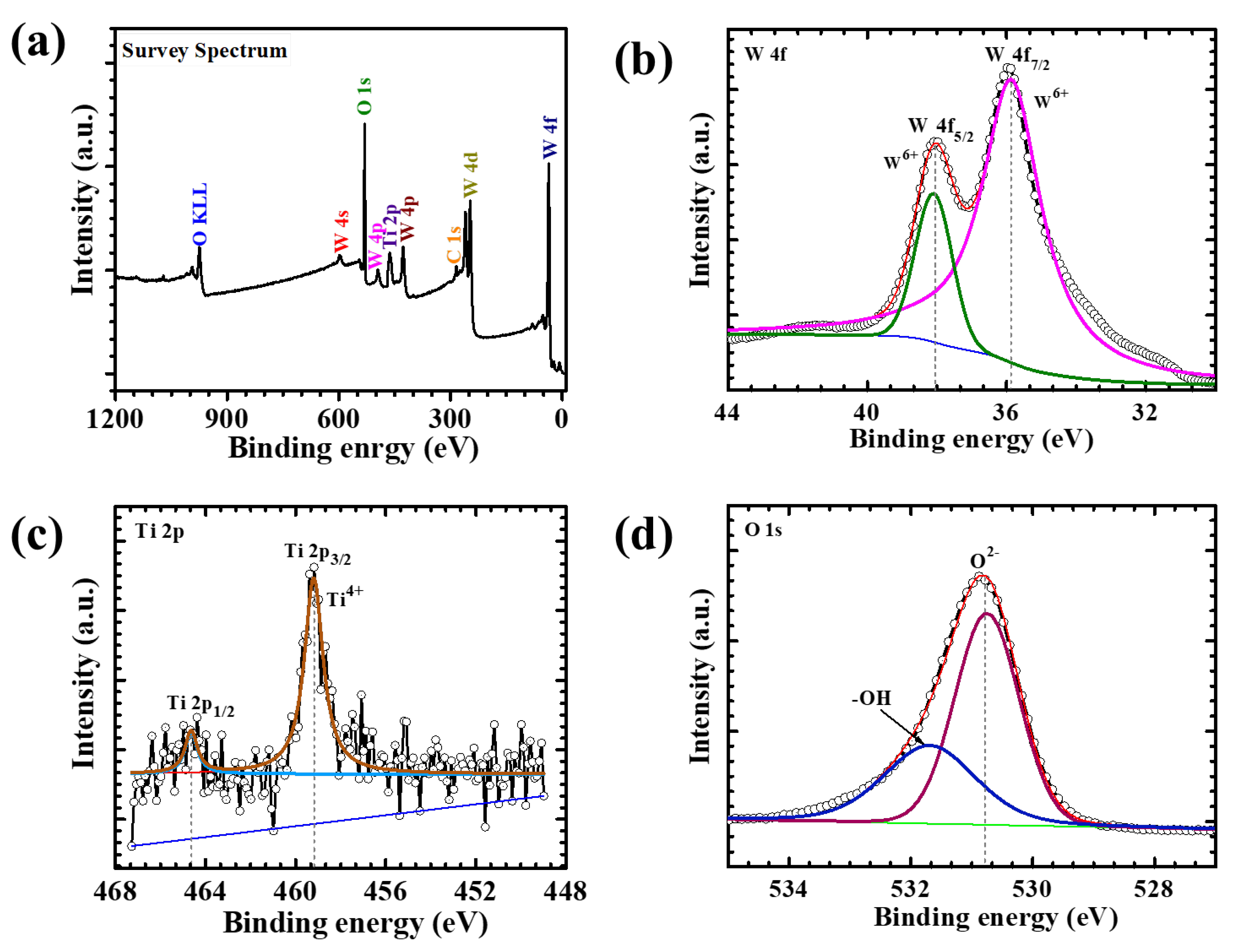
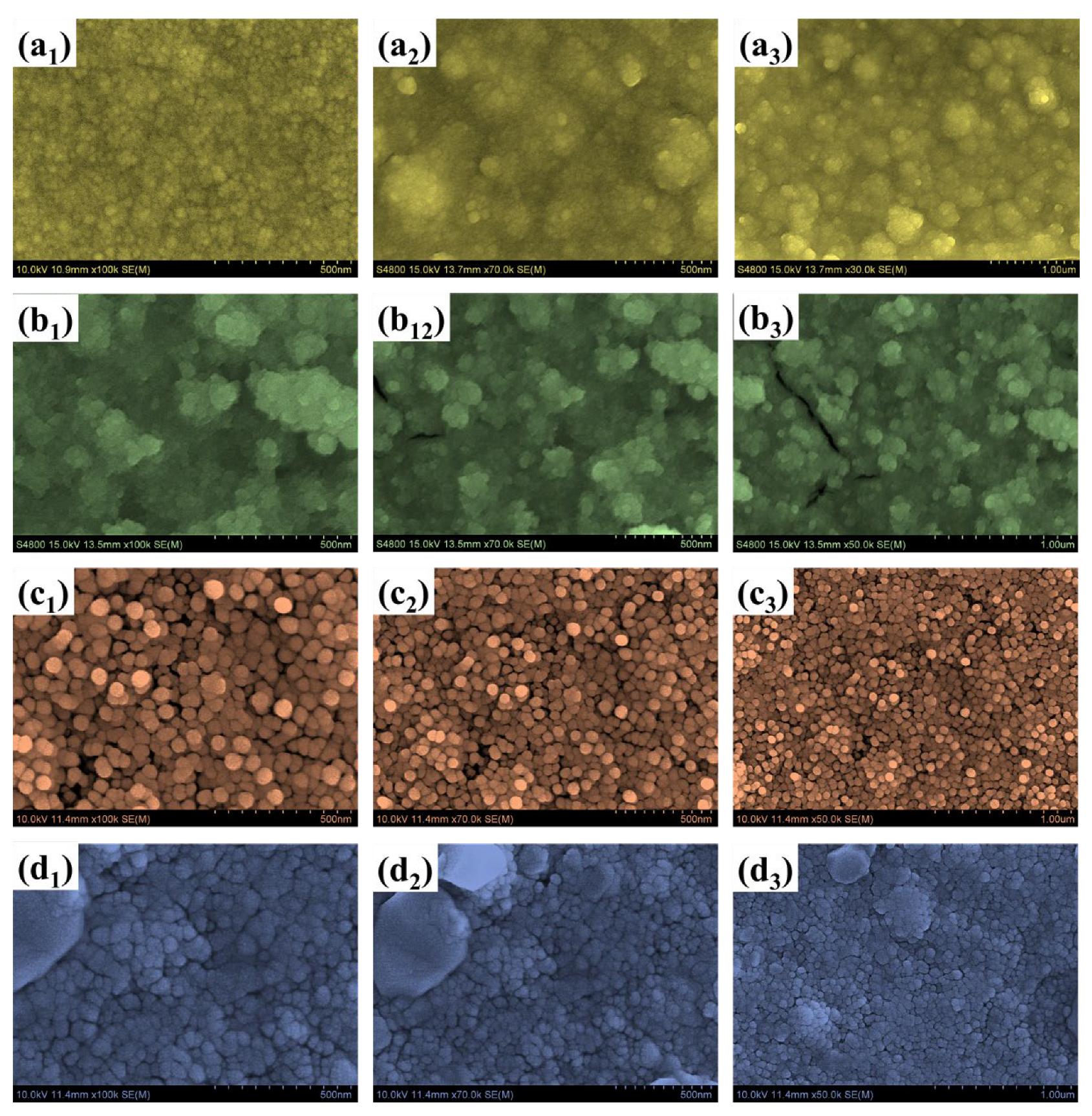



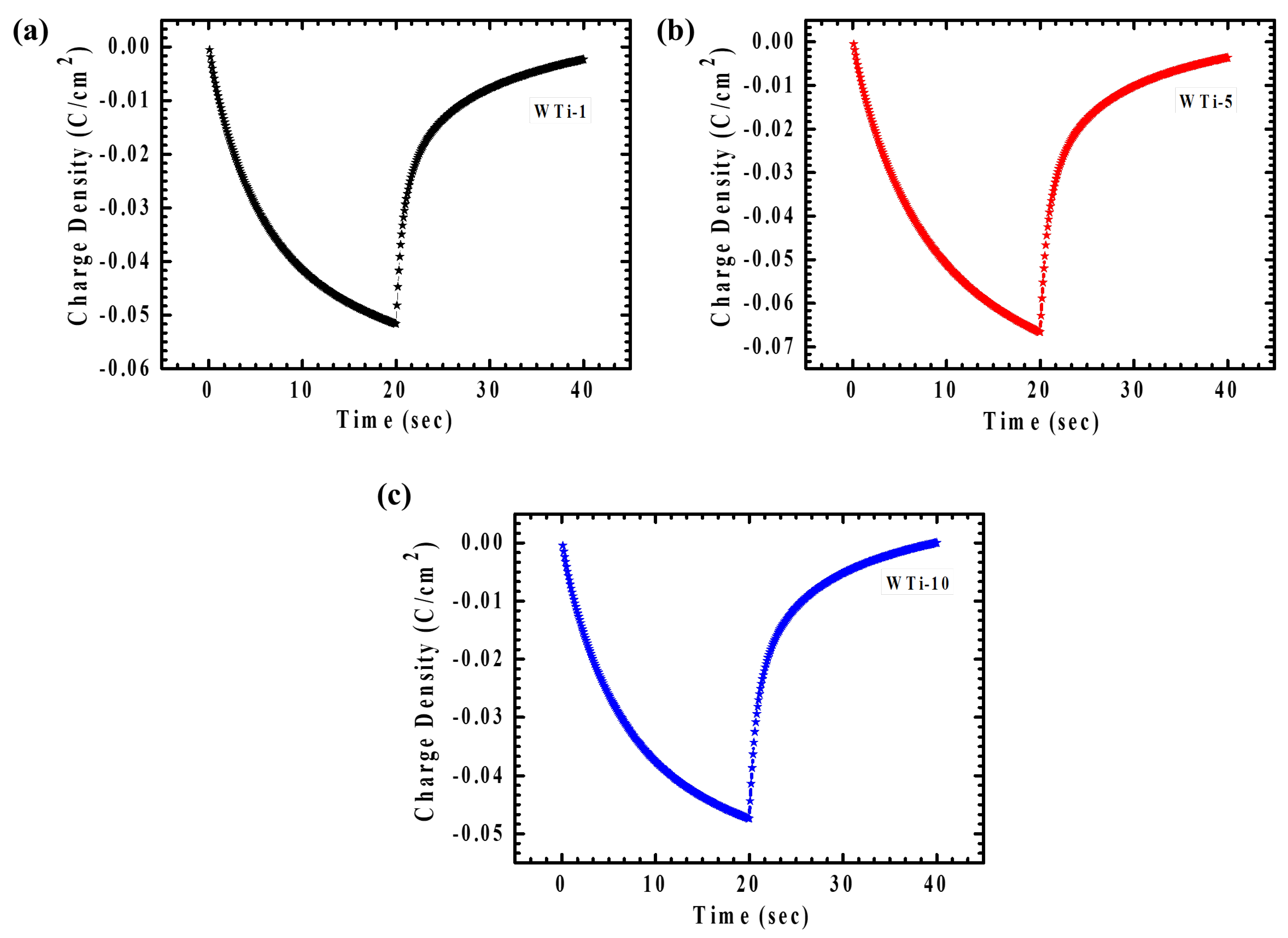
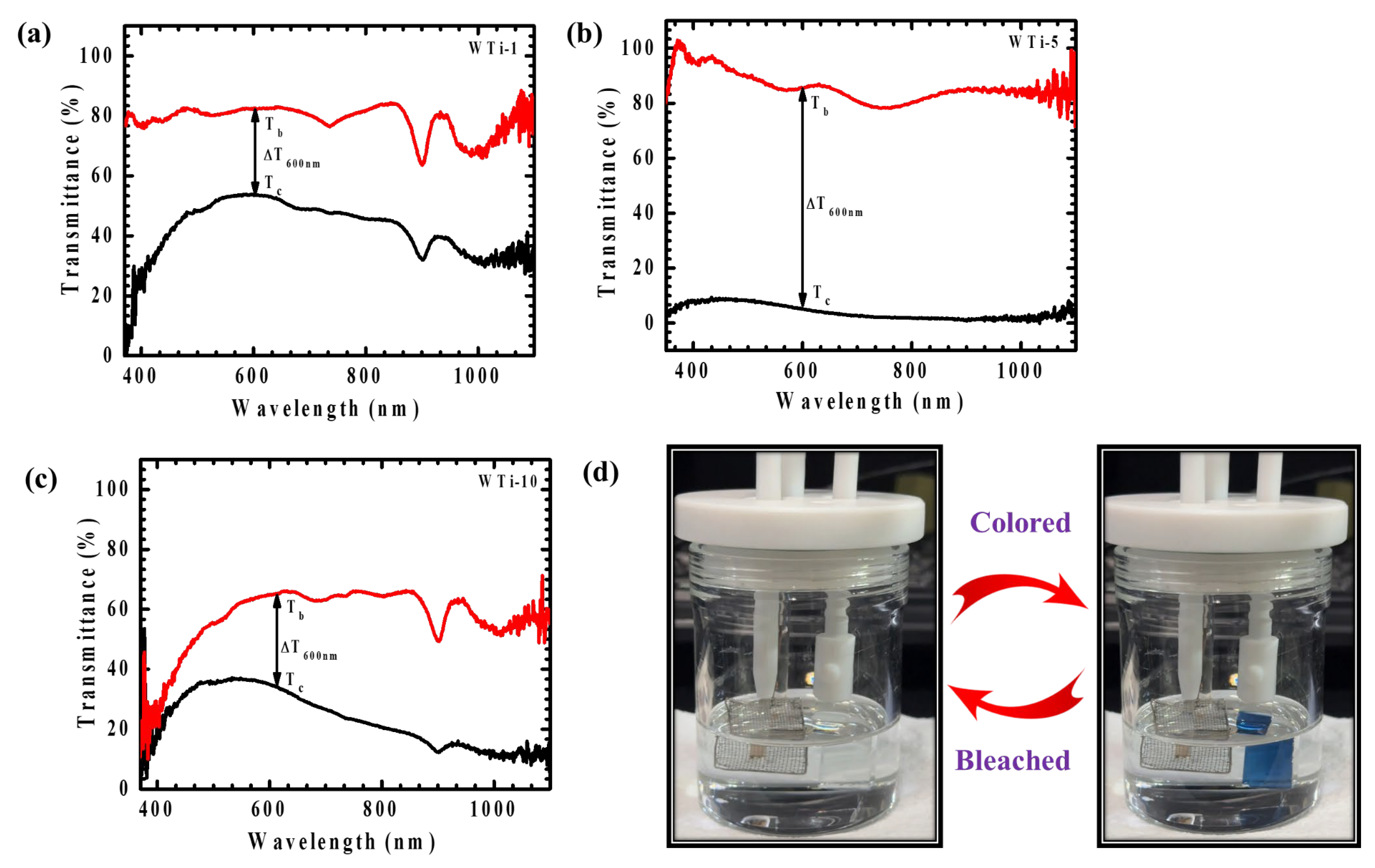


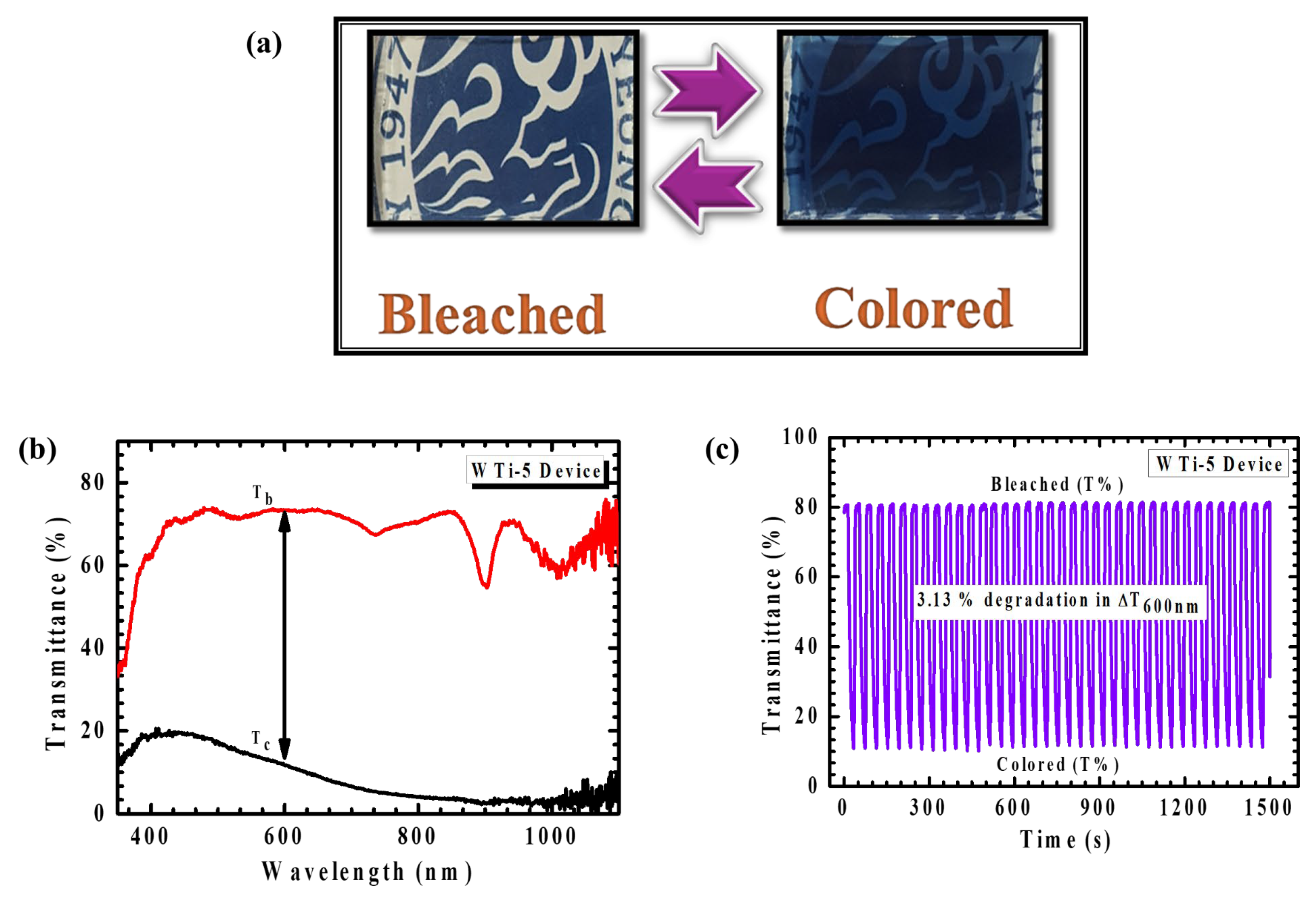
| Technique | Feature | Position (2θ or BE) | Assignment | Phase/Oxidation State |
|---|---|---|---|---|
| XRD | (110) | 27.4° | TiO2 crystal plane | Rutile TiO2 (JCPDS 01-088-1175) |
| XRD | (101) | 36.1° | TiO2 crystal plane | Rutile TiO2 |
| XRD | (211) | 54.3° | TiO2 crystal plane | Rutile TiO2 |
| XRD | (310) | 69.0° | TiO2 crystal plane | Rutile TiO2 |
| XRD | Broad hump | 20–27° | Amorphous background (WO3 base layer) | Amorphous WO3 |
| XPS | W 4f7/2 | 35.7 eV | Spin–orbit peak of tungsten | W6+ in WO3 |
| XPS | W 4f5/2 | 37.8 eV | Spin–orbit peak of tungsten | W6+ in WO3 |
| XPS | Ti 2p3/2 | 458.5 eV | Spin–orbit peak of titanium | Ti4+ in TiO2 |
| XPS | Ti 2p1/2 | 464.2 eV | Spin–orbit peak of titanium | Ti4+ in TiO2 |
| XPS | O 1 s (lattice oxygen) | 530.2 eV | Lattice oxygen in metal oxides | O2- |
| XPS | O 1 s (surface species) | 531.5 eV | Surface hydroxyls/chemisorbed O | - |
| Sample Name | Charge Intercalation ) (C/cm2) | Charge Deintercalation ) (C/cm2) | Reversibility (%) | Coloration Time (sec) (tc) | Bleaching Time (sec) (tb) | Tb% | TC% | Optical Modulation (ΔT600nm%) | Optical Density (ΔOD) | Coloration Efficiency (cm2/C) |
|---|---|---|---|---|---|---|---|---|---|---|
| WTi-1 | 0.051 | 0.050 | 98.03 | 8.7 | 3.1 | 81.37 | 53.02 | 31.07 | 1.53 | 30.00 |
| WTi-5 | 0.066 | 0.065 | 98.48 | 15.4 | 6.2 | 86.32 | 4.16 | 82.16 | 6.06 | 128.93 |
| WTi-10 | 0.047 | 0.046 | 97.80 | 14.1 | 5.8 | 66.05 | 35.47 | 30.58 | 1.20 | 25.53 |
| Material | Method | Morphology | ΔT% | Coloration Efficiency (cm2/C) | Coloration Time (tc; sec) | Bleaching Time (tb; sec) | Stability | Ref. |
|---|---|---|---|---|---|---|---|---|
| TiO2@WO3 | Hydrothermal and electrodeposition | Nanorods | 57.2 | 67.5 | 5.4 | 6.4 | 10,000 cycles | [12] |
| TiO2/WO3/TiO2 | Magnetron sputtering | Compact and dense nanogranules | 94.72 | 479.3 | 5.6 | 2.9 | 7000 cycles | [13] |
| TiO2-WO3 | Doctor blade and electrodeposition | Nanopores | - | 55.1 | - | - | - | [15] |
| TiO2/WO3 | Spin coating | Nanograins | 75 | - | - | - | - | [16] |
| TiO2/WO3 | Hydrothermal | Nanotrees | 79.5 | 443.4 | 1.9 | 14.8 | 10,000 | [17] |
| TiO2–Co3O4 | Hydrothermal | Nanorods | - | 91 | - | - | - | [18] |
| Nb2O5 | Solvothermal | Spherical particles | 69 | 85.9 | 10.6 | 0.7 | 400 cycles | [30] |
| NiO | E-beam evaporation | granular | 66 | 55 | 3.6 | 1.4 | 200 cycles | [32] |
| V2O5 | Crystal-assisted electrodeposition | Nanorod | 27.43 | 25.2 | 8.8 | 9.3 | - | [33] |
| NiO | Sol–gel dip coating | Nanorod | 68 | - | 5.6 | 2.3 | 1200 cycles | [34] |
| WO3/TiO2 | Electrodeposition and hydrothermal | Spherical | 82.16 | 128.93 | 15.4 | 6.2 | 5000 | This Work |
Disclaimer/Publisher’s Note: The statements, opinions and data contained in all publications are solely those of the individual author(s) and contributor(s) and not of MDPI and/or the editor(s). MDPI and/or the editor(s) disclaim responsibility for any injury to people or property resulting from any ideas, methods, instructions or products referred to in the content. |
© 2025 by the authors. Licensee MDPI, Basel, Switzerland. This article is an open access article distributed under the terms and conditions of the Creative Commons Attribution (CC BY) license (https://creativecommons.org/licenses/by/4.0/).
Share and Cite
Morankar, P.J.; Amate, R.U.; Bhosale, M.K.; Jeon, C.-W. PVP-Engineered WO3/TiO2 Heterostructures for High-Performance Electrochromic Applications with Enhanced Optical Modulation and Stability. Polymers 2025, 17, 1683. https://doi.org/10.3390/polym17121683
Morankar PJ, Amate RU, Bhosale MK, Jeon C-W. PVP-Engineered WO3/TiO2 Heterostructures for High-Performance Electrochromic Applications with Enhanced Optical Modulation and Stability. Polymers. 2025; 17(12):1683. https://doi.org/10.3390/polym17121683
Chicago/Turabian StyleMorankar, Pritam J., Rutuja U. Amate, Mrunal K. Bhosale, and Chan-Wook Jeon. 2025. "PVP-Engineered WO3/TiO2 Heterostructures for High-Performance Electrochromic Applications with Enhanced Optical Modulation and Stability" Polymers 17, no. 12: 1683. https://doi.org/10.3390/polym17121683
APA StyleMorankar, P. J., Amate, R. U., Bhosale, M. K., & Jeon, C.-W. (2025). PVP-Engineered WO3/TiO2 Heterostructures for High-Performance Electrochromic Applications with Enhanced Optical Modulation and Stability. Polymers, 17(12), 1683. https://doi.org/10.3390/polym17121683







